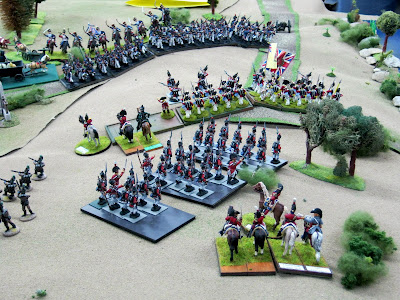 |
| Battle of the Coa River Bridge. French Commander Rob O. contemplates the destruction of Crauford's Light Division. |
Battle Report provided by Der Alte Fritz
We enjoyed our Battle of the Coa River Bridge scenario so much that we thought that we would try it again on November 10, 2012. The British team counted on their experiences from the first game to help them come up with a winning strategy that would allow them to retreat across the Coa River with minimal losses. click on the link below to see how the previous Coa scenario turned out.
Previous Coa River Refight
As before, the British army was vastly outnumbered by the attacking French corps of Marshal Ney.
British Left Flank
83rd Regt (84 figures)
94th Regt (84 figures)
Portuguese Cacadores - Rifles (12 figures)
British Centre
9th Regiment (110 figures)
5th Regiment (100 figures)
Grant's RHA battery (six 6-pounders)
1/95th Rifles (one company of 12 figures)
British Right Flank
Royal Marines (32 figures)
1/95th (36 figures in 3 coys)
5/60th (36 figures in 3 coys)
British Light Cavalry Brigade:
2 sqds 15th Hussars (24 figures)
2 sqds 16th Light Dragoons (24 figures)
Total British Forces:
420 infantry
96 Rifles
6 x 6pdrs RHA
48 Light Cavalry
Marshal Ney's French VI Corps
I don't recall exactly how many French there were or what their specific regiments were, but memory indicates the following:
French Right Wing - 3 btns of 72 figures
French Centre - 3 btns of 72 figures
French Left - 4 btns of 72 figures
French field artillery (3x 8pdrs and 1 x 5" howitzer)
20th Dragoon - 40 figures
Vistula Lancers - 20 figures
1st Chasseurs - 24 figures
Italian Chasseurs - 20 figures
Total French Forces:
720 Infantry
6 cannon
104 Light Cavalry
 |
| The Coa River and the single bridge representing the British Light Division's line of retreat. |
 |
| Grant's battery of RHA deploys on one of the ridges awaiting the French attack. |
 |
| Three companies of the 5/60th Rifles deploy in front of the Coa river crossing. |
I had thought that our plan was to place all of the British Rifles on the other side of the Coa River, from whence they could provide covering fire with their long range rifle fire. Using rested fire and elite firing bonuses, the combined 72 rifles should have posed a challenge to the French. In practice, half of the Rifles deployed on the wrong side of the river and there was only a half regiment of Marines to cover the bridge. I had imagined that a full regiment of 100+ British infantry were going to be deployed to cover the bridge. Somehow our plans were misinterpreted or incorrectly implemented.
In all of the excitement of the pre-battle planning and game setup, I never got around to calling the other British players together to form a battle plan. We all sort of knew what the scenario was and the problems that we had to contend with, but without an overall plan, we were doomed. This loss is on me.
In all of the excitement of the pre-battle planning and game setup, I never got around to calling the other British players together to form a battle plan. We all sort of knew what the scenario was and the problems that we had to contend with, but without an overall plan, we were doomed. This loss is on me.
 |
| Two companies of the 1/95th Rifles provide cover on the far side of the Coa crossing. |
 |
| Ney's Corps commences the attack on the British left flank, defended by the 83rd Regt. of Foot. |
The picture above shows four battalions of French infantry attacking the 83rd Regiment, holding the British left flank, from the front, while another three battalions of infantry, shown below, attacked from the flank. Thus, the 83rd were in a salient of sorts and about to receive seven French battalions within a couple of game turns. Ouch.
 |
| The French attack the British left from front and from the flank. Voltigeur companies preceed the advance of the French infantry brigades. |
 |
| Grant's RHA battery opens a deadly salvo on its French artillery counterpart early in the game. |
 |
| British center |
The British center was held by two 110 figure battalions of infantry, holed up in several haciendas.They faced off against one of the French brigades (3 btns of 72 figures), the French artillery, and all of the French cavalry.
 |
| The British left flank is also threatened by another brigade of French infantry. Things are not looking good for the Red Coats today. |
 |
| Marshal Ney (foreground): "Plans? Our plans are to destroy zee Rosbifs!" |
As in the previous game, the French strategy was to attack the British left flank from two directions and smash this part of the British army. At the same time, all of their cavalry and a brigade of infantry would race towards the Coa River bridge and attempt to capture it or otherwise cut off the British line of retreat across this single choke point.
The British only had a half regiment of British Marines (36 figures) and five companies of Rifles to hold the bridge and escape route. Somehow, the British failed to make any plans prior to the start of the battle, as a result, there was no significant force on the British right flank available to defend the bridge. The French successfully cut off the line of retreat across the Coa, and I daresay that Marshall Ney probably bagged the entire Light Division.
Needless to say, it was a very sad day back in Lisbon at general headquarters.
 |
| "Sacre Bleu! Zee plan is working!" |













































